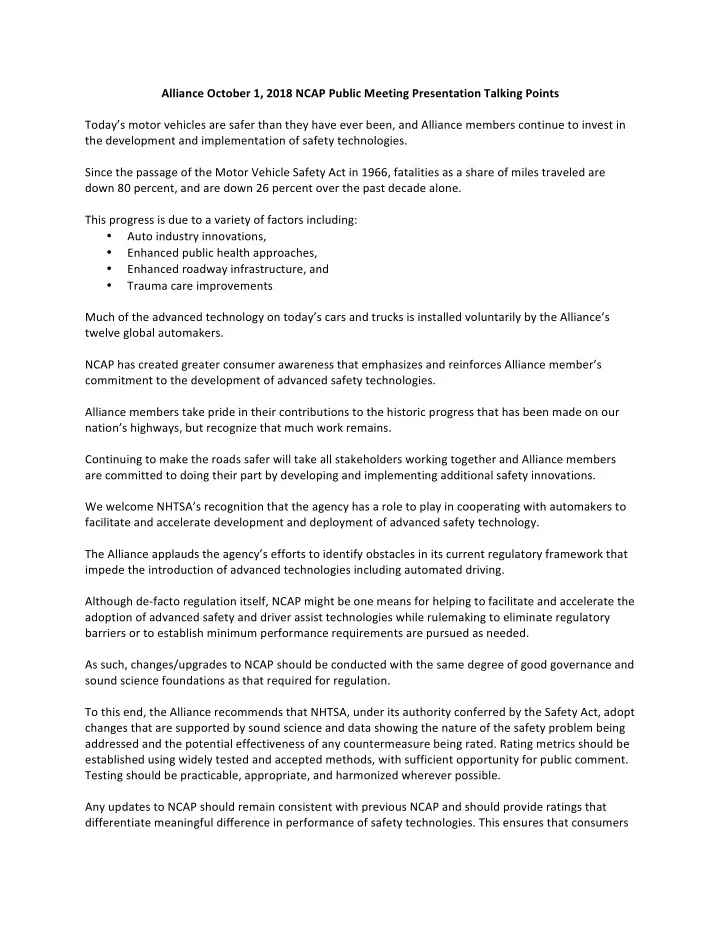

Alliance October 1, 2018 NCAP Public Meeting Presentation Talking Points Today’s motor vehicles are safer than they have ever been, and Alliance members continue to invest in the development and implementation of safety technologies. Since the passage of the Motor Vehicle Safety Act in 1966, fatalities as a share of miles traveled are down 80 percent, and are down 26 percent over the past decade alone. This progress is due to a variety of factors including: Auto industry innovations, • Enhanced public health approaches, • Enhanced roadway infrastructure, and • Trauma care improvements • Much of the advanced technology on today’s cars and trucks is installed voluntarily by the Alliance’s twelve global automakers. NCAP has created greater consumer awareness that emphasizes and reinforces Alliance member’s commitment to the development of advanced safety technologies. Alliance members take pride in their contributions to the historic progress that has been made on our nation’s highways, but recognize that much work remains. Continuing to make the roads safer will take all stakeholders working together and Alliance members are committed to doing their part by developing and implementing additional safety innovations. We welcome NHTSA’s recognition that the agency has a role to play in cooperating with automakers to facilitate and accelerate development and deployment of advanced safety technology. The Alliance applauds the agency’s efforts to identify obstacles in its current regulatory framework that impede the introduction of advanced technologies including automated driving. Although de-facto regulation itself, NCAP might be one means for helping to facilitate and accelerate the adoption of advanced safety and driver assist technologies while rulemaking to eliminate regulatory barriers or to establish minimum performance requirements are pursued as needed. As such, changes/upgrades to NCAP should be conducted with the same degree of good governance and sound science foundations as that required for regulation. To this end, the Alliance recommends that NHTSA, under its authority conferred by the Safety Act, adopt changes that are supported by sound science and data showing the nature of the safety problem being addressed and the potential effectiveness of any countermeasure being rated. Rating metrics should be established using widely tested and accepted methods, with sufficient opportunity for public comment. Testing should be practicable, appropriate, and harmonized wherever possible. Any updates to NCAP should remain consistent with previous NCAP and should provide ratings that differentiate meaningful difference in performance of safety technologies. This ensures that consumers
can easily understand the rating system and make smart purchasing decisions, spurring safety goals that exceed regulatory requirements. For crashworthiness elements that require the use of ATDs, Part 572 rulemaking is essential to ensure that the specified devices and, repeatable/reproducible, durable, and have a full technical data package that is in the public domain. In fact, we also recommend that other significant items of test hardware, such as vehicle or pedestrian surrogates be subjected to a similar process to ensure they are appropriately suitable for use. In addition, injury risk curves and injury metrics must be biomechanically sound and related to and supported by field data. As a result, the Alliance is conducting research to help identify/develop more bio-fidelic metrics and assessment values to evaluate head injury potential. We will provide the results of this research when it is completed. NCAP should avoid forcing differentiation for differentiation sake – Changes must have demonstrated safety benefit. Driving injury metrics down to the point where test devices cannot meaningfully measure and/or where incremental safety benefits become infinitesimal should be avoided. As such, it is important that any new additions to NCAP significantly increase real-world safety. If not, they will only increase vehicle cost without any commensurate real-world safety benefit. As we contemplate revisions to NCAP, as well as other safety initiatives, it is important to spend the public’s safety dollars wisely, prioritizing highest benefit and lowest cost. This is especially critical because increasing vehicle cost can have a negative impact on the purchase of new vehicles with improved safety and fuel economy/environmental benefits. In addition to our recommendations, it is important for the agency to develop and periodically update a long-term road map. This is especially critical given vehicle manufacturers’ 4-5 year product development cycles. Our specific recommendations are to: Establish a Federal advisory committee to: • o Develop, implement, and periodically update a long-term roadmap for NCAP that considers, the macro effect on motor vehicle safety; o Oversee the identification and prioritization of safety opportunities that lend themselves to a market based/consumer information approach; Coordinate with other NCAP and consumer rating organizations to avoid potential o duplication or conflicts. Establish procedures for selecting advanced safety and connected vehicle technologies o to be rated; Oversee the development of test procedures, ATDs, test fixtures, and safety o performance metrics to be used to rate advanced safety and connected vehicle technologies;
o Oversee the development of a rigorous and science-based means for providing consumers with an overall safety rating(s) that distinguishes meaningful performance differences in a simple and easy to understand manner. Conduct periodic effectiveness evaluations o As the agency mentioned in the notice announcing this public meeting, the December 2015 request for comments resulted in nearly 300 sets of written comments. This notice proposed a wide range of potential changes. In our comments, we noted that many of the proposed changes were not fully developed or supported. The Alliance recommends that before making significant changes to the NCAP program, NHTSA issue an additional notice providing the technical details and supporting justifications, with an opportunity to provide additional comments specific to the contents of that proposal. NCAP should be viewed as only one element of an overall NHTSA priority/operational plan that is based on a thorough examination of the Haddon Matrix to identify and prioritize safety opportunities and spend the public’s resources (safety dollars) effectively by identifying and implementing the highest benefit/lowest cost solutions first.
Recommend
More recommend